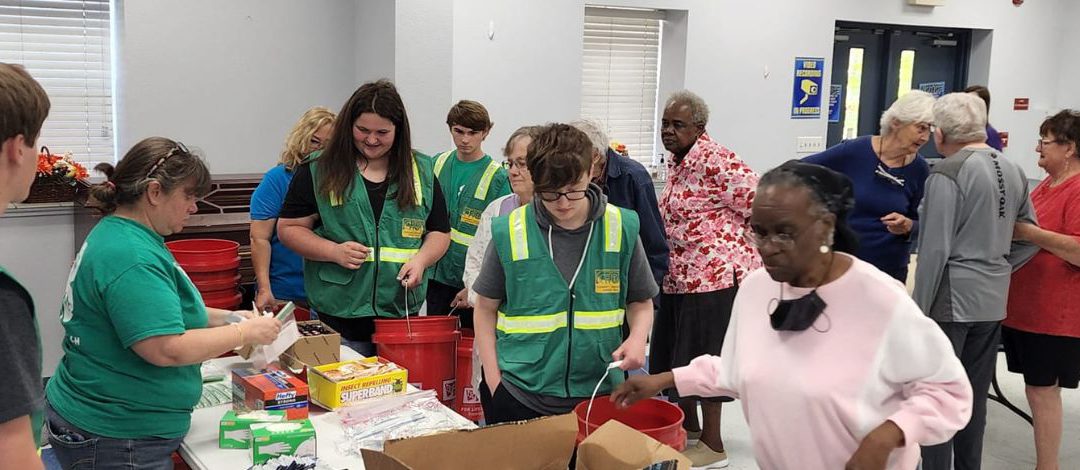
by Rachel Pienta | May 8, 2023
4-H functions most effectively as a youth-adult partnership that fosters positive youth development. Youth-adult partnerships can take several forms. One form is a mentoring relationship between a caring adult volunteer and a 4-H youth.
Mentoring is a relationship-based process that occurs over time. The mentoring process can be formal or informal. This blog post will explore what it means to be a mentor and the importance of mentoring roles in youth development. The person being mentored may be referred to as a protégé or as a mentee. Mentoring is not a one-way relationship. The relationship can fulfill professional and socioemotional needs for both mentor and protégé (Inzer & Crawford, 2005).
Formal mentoring tends to occur within an organizational structure. A senior member of an organization or an adult may be assigned to serve in a mentoring role to a new member or to a youth. Informal mentoring relationships are voluntarily formed between two people who choose each other (Inzer & Crawford, 2005). A third, hybrid approach known as youth-initiated mentoring (YIM) is also an option as a model and may be optimal for building mentor relationships in 4-H programs (van Dam L. B., 2021).

Mentors play one or more of these five roles for mentees.
5 Roles of the Mentor
The following mentoring roles can be accomplished within a formal or informal mentor relationship:
- Goal Setter: Help identify and prioritize the goals of the person you are mentoring.
- Adviser: Provide advice and guidance, often based on life experience and organizational knowledge.
- Cheerleader: Encourage positive actions and celebrate success.
- Growth Cultivator: Suggest activities that will help the person grow.
- Role Model: Serve as a model of potential success and provide real-life examples of how to surmount obstacles.
Goal Setter: The mentor as goal setter helps the youth to identify potential goals to set. Mentors can also play an important role in teaching youth how to balance and prioritize goals. For example, Susy may want to win a blue ribbon at the livestock show. At the same time, Susy is also trying to maintain a 4.0-grade average and work part-time. Susy’s mentor can help her to set realistic goals that help her to develop time management skills.
Adviser: It can be helpful for youth to learn from the experiences of others. For example, Michael wants to become state 4-H president. He has connected with adult volunteer Cory, who was state president when he was a 4-H youth. Cory serves as a sounding board and often shares how he learned from mistakes and was able to build on his successes to achieve his leadership goal.
Cheerleader: The cheerleader role may seem simple but also the most important. Celebrating youth successes – whether large or small – can make a big difference in a child’s life. Marking success with recognition and encouragement helps to reinforce positive behavior and helps to build a foundation for continued achievement. For example, Anna has been working on her aim during archer
y club practice. She wants to compete in an upcoming match. You observe her stance and coach her to adjust her posture. Anna is now able to hit the center target three out of four times. You praise her improvement and celebrate the achievement with her, sharing an exuberant high five.
Growth Cultivator: 4-H professionals and volunteers often refer to growing leaders and “making the best better” – the growth cultivator does these things. As a growth cultivator, a mentor helps to point youth in the direction of the next and most appropriate challenge that will help foster positive development. For example, Nathan has prepared a strong project board display for the county fair. You suggest he use that project board to develop an illustrated talk for district showcase.
Role Model: Serving as a role model for youth may seem like a full-time job! However, the key part of being a role model is honesty. Role models do not have to be perfect, but modeling honesty and how to be accountable when mistakes are made are critical elements of being a good role model. For example, you are usually early to club activities, greeting everyone with a smile and a personal acknowledgment when they come through the door. On the way to a district council meeting, you encounter heavy traffic and run late. When you arrive, your club youth members are already there and a 4-H agent has started the meeting. At the break, you shrug off your poor mood and tell your youth, “I didn’t leave early enough to allow for rush hour traffic. That is on me. I appreciate how you were all here on time and were able to participate in the meeting before I arrived.”
3 Key Elements of Effective Mentoring
A robust, growing body of research on youth mentoring suggests that a hybrid model of targeted mentoring and relational bond mentoring may produce the best outcomes for youth development (Christensen, 2020). Targeted mentoring involves a relationship focusing on a specific outcome or behavior – such as academic or career mentoring. Relational bond mentoring focuses on developing rapport and may present a more holistic approach. 4-H is built on a developmental model that uses this hybrid approach. Youth-adult relationships may initially form to reach specific goals – such as completing a project. Over time, as the youth becomes more involved with the program, relational bonds may develop. Research by Raposa et al (2019) suggests that effective youth mentoring involves an “interconnected set of three processes (i.e., social-emotional, cognitive, and identity formation processes) through which the establishment of close, caring relationships with non-parental adults are expected to promote positive developmental trajectories” (Raposa, 2019). Effective youth mentoring is likely to incorporate all three of these elements: social-emotional, cognitive, and identity formation processes.
How Does Youth-Initiated Mentoring (YIM) Work?
4-H can have an important role in providing a structured, safe environment where youth choose and develop mentoring relationships. One way to establish these type of mentoring relationships is youth-initiated mentoring (YIM). YIM is a hybrid approach in which youths and their families are helped to identify and recruit caring adult mentors from within their existing social networks (van Dam L. R., 2021).
The 4-H youth-adult partnership model provides a structure for helping youth to identify, recruit, and maintain connections with caring adults (van Dam L. B., 2021). The key elements in YIM are youth agency and choice in establishing and maintaining relationships.
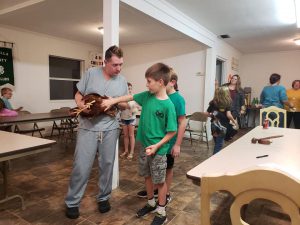
Club leader teaches poultry anatomy to youth.
Which Type of Mentor Role Fits?
The mentor role that best fits you and your mentee may incorporate one or more of the five mentor roles. It is likely that at some point during a long-term mentoring relationship a mentor will have played all of the five roles in supporting their mentor.
Become a Mentor with 4-H!
As a 4-H volunteer, you will opportunities to serve as a mentor to youth looking to form relationships with caring adults. To learn more about how to get involved, reach out to your local UF/IFAS County Extension office.
References:
- Christensen, K. H. (2020). Non-Specific versus Targeted Approaches to Youth Mentoring: A Follow-up Meta-analysis. Journal of Youth and Adolescence, 959–972.
- Inzer, L., & Crawford, C. (2005). A Review of Formal and Informal Mentoring: Processes, Problems, and Design. Journal of Leadership Education, 33-50.
- Raposa, E. R. (2019). The Effects of Youth Mentoring Programs: A Meta-analysis of Outcome Studies. Journal of Youth and Adolescence, 423–443.
- van Dam, L. B. (2021). Youth Initiated Mentoring: A Meta-analytic Study of a Hybrid Approach to Youth Mentoring. J Youth Adolescence, 219–230.
- van Dam, L. R. (2021). Youth-Initiated Mentoring as a Scalable Approach to Addressing Mental Health Problems During the COVID-19 Crisis. JAMA Psychiatry, 818.
by Rachel Pienta | Dec 9, 2022
What is a Youth-Adult Partnership?
“Youth-adult partnership” is a frequently used phrase among 4-H leaders, volunteers, and members. Volunteer club leaders are encouraged to foster youth-adult partnerships in the community club environment. What is a youth-adult partnership? How would a volunteer club leader begin to create this type of partnership? What is the adult role in the youth-adult partnership? Research shows that “caring, knowledgeable, and skilled adults can contribute to the success of young people as they grow and develop (Norman and Jordan, 2006). The first step in creating a youth-adult partnership is being the adult who wants to foster that environment in their 4-H club.
Positive Youth Development
4-H programs are built on a Positive Youth Development foundation. To further unpack what that phrase means, let’s begin with defining youth development. Norman and Jordan (2006) define “Youth development as an ongoing process through which young people attempt to meet their needs and to develop the competencies they perceive as necessary for survival and transition to adulthood.” When youth development is positive, this development has positive benefits and outcomes for the youth and the community. While youth development is a youth-focused process experienced by the youth, adults can and do play a role in this process. Adult leaders have the unique and special role of creating environments that provide opportunities to develop and grow in positive ways.
Zone of Proximal Development and the Role of the Adult Leader
Sociologist Lev Vygotsky studied how children learn and acquire skills. Through his research, he was able to determine that children can develop and learn to a certain point based on prior experience and knowledge. With the help of an adult teacher or leader, the child can learn more and acquire skills beyond what he or she might be able to accomplish without adult help. This learning theory is known as the “Zone of Proximal Development” (Vygostky, 1978). In 4-H, reaching the zone of proximal development where the youth-adult partnership empowers youth members to achieve is the goal we work to reach.
Working with Youth as Partners
The origin of today’s 4-H youth-adult partnership model is rooted in the work of sociologist William Lofquist. Lofquist (1989) developed the “Spectrum of Attitudes” to describe adult attitudes and approaches to working with youth. The Spectrum of Adult Attitudes places attitudes towards young people into three categories: Youth as objects; Youth as recipients; and Youth as partners (Williams, 2016). Lofquist noted that adult attitudes and the behaviors that result from these attitudes were not necessarily linear or clear cut. Youth needs may drive adult behaviors at different points in the learning and partnership process. In 4-H, adult leaders strive to transition youth from being knowledge recipients to being partners in learning and doing.

High school-age 4-H youth members plan and lead a 4-H robotics club.
Getting Started
Adults can foster and support successful youth-adult partnerships by creating and “providing environments for youth that are safe and nurturing and by expanding opportunities for experiences that will help young people develop skills they need for adulthood” (Norman and Jordan, 2006).
The idea of moving from an adult-led club to a club that operates as a youth-adult partnership may seem intimidating. Where do we start? How does it work? Volunteer club leaders may find that it takes a while to develop a community club that functions as a successful youth-adult partnership. Adults and youth may learn together as adults yield control and youth step into expanded leadership roles.
Tips for Establishing a Youth-Adult Partnership
In the club setting, creating space for shared decision-making can help build the youth-adult partnership. When adults make decisions “with” rather than “for” youth, space is created for youth voices to be heard, for youth decisions to be validated, and for youth to develop as leaders.
When youth make decisions about activities and projects, they begin to have ownership over the club experience and move toward acting as fully empowered partners with adult leaders.
How can adults create an environment that gives youth space to develop and grow as partners? Adult leaders can start building the youth-adult partnership by helping youth develop key skills to lead and run club meetings. Steps to reaching an effective youth-adult partnership include the following activities:
- Electing youth officers and providing officer training.
- Providing whole club training in parliamentary procedure with meeting procedure practice.
- Agenda planning that includes youth and adults.
- Adults joining youth-led meetings as participants.
- Setting ground rules so that everyone is heard and respected
Getting Started
For more information and resources on 4-H clubs and youth-adult partnerships, reach out to your local Extension office or 4-H agent.
We also have several tools and resources for office training, parliamentary procedure games, and agenda planning on our Northwest 4-H Volunteer Google Site. If you would like some hands-on training, make plans to attend our Northwest 4-H Volunteer Forum January 20-21 in Destin, Florida. Registration is available on 4HOnline
References
Lofquist, W. 1989. The technology of prevention workbook: A leadership development program. Tucson, AZ: Associates for Youth Development Publications.
Norman, M.N. and Jordan, J.C. 2006. Introducing 4-H youth development. EDIS 4HFFS101.2, one of a series of the 4-H Youth Development Department, UF/IFAS Extension. Original publication date February 2006. Reviewed July 2018. Visit the EDIS website at http://edis.ifas.ufl.edu.
Vygotsky, L. 1978. Interaction Between Learning and Development. In Gauvain & Cole (Eds.) Readings on the Development of Children. New York: Scientific American Books. pp. 34-40
Williams, C.D. 2016. What is authentic youth engagement? The Governor’s Office for Children. Maryland.gov. https://goc.maryland.gov/authentic-youth-engagement/.
Additional Resources
A 4-H Club Meeting
4-H Club Management
4-H Clubs that Youth Choose to Attend
Running a Smooth 4-H Business Meeting
by Rachel Pienta | Sep 12, 2022
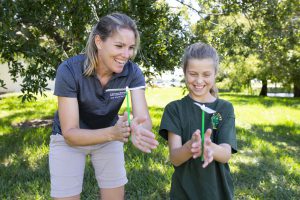
.
What is Subject Matter Expertise?
Subject matter expertise refers to the “technical knowledge and skills possessed to perform tasks related to a specific field(s)” (Harder, 2019). While county 4-H professionals (also known as agents) often bring subject matter expertise in one or more areas to the job, the subject matter expertise of program volunteers helps to expand the availability of potential program offerings. As an organization, 4-H strives to provide opportunities for learning evidence-based content (subject matter) and apply age-appropriate positive youth development (PYD) strategies to facilitate experiential learning via a collaborative youth-adult partnership.
What is a Subject Matter Expert?
Subject Matter Experts (SMEs) “are professionals who have advanced knowledge in a specific field” (Indeed, 2020). Generally, an SME will have “a deep understanding of a particular job, process, department, function, technology, machine, material or type of equipment” (Reh, 2020). In the workplace, being known as an SME is part of a career trajectory and this role or status is often based on a combination of education or training and experience. In the 4-H setting, it is possible that a subject matter expert has gained expertise through informal learning and hands-on experience. The 4-H subject matter expert may not always work professionally in the area of expertise that they bring to 4-H. For example, a skilled volunteer may work as a nurse in their professional career but leads a 4-H sewing club where she can share a deep knowledge subject knowledge and extensive skills gained through years of practice and self-guided study.
Why is Subject Matter Expertise Important to 4-H?
In 4-H, adult staff members and community volunteers work as partners with youth members to help youth “learn by doing.” The 4-H learning experience is based on the idea that “learning is an integrated process where the learner, the educator, the physical space, and culture all are changed by each other” (NIFA, 2016). 4-H clubs provide youth with opportunities to learn subject matter and develop life skills (Knowles and Diem, 2018).
While adults and youth may learn a new skill or acquire new knowledge together in a discovery process, the most common 4-H experience involves working with a subject matter expert who will help to facilitate experiential learning. 4-H learning is intended to be a “dynamic experience in a shifting learning ecosystem” (NIFA, 2016). Together, 4-H staff and community volunteers work together to bring new research and best practices into the learning experience.
How Do We Find Subject Matter Experts?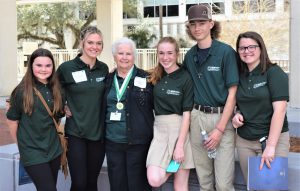
One way that 4-H can provide specialized subject matter content is through partnerships. For example, 4-H has been successful in partnering with industry professionals and university faculty to implement a variety of STEM programs. A multiyear partnership with NASA has provided many opportunities for youth to explore the world of aerospace science. However, it is not necessary to be a rocket scientist to have subject matter expertise that can be helpful to a 4-H program.
In 4-H, agents have several options available to help develop volunteer subject matter expertise. Agents may look for potential volunteers with specific subject matter expertise to match youth interests. Another option is to engage a caring adult volunteer with a desire to learn an unfamiliar skill or acquire a new knowledge set. For example, a 4-H agent with youth members who want to have a beekeeping club may find a local beekeeper to be a club leader. Another way to match a volunteer with a potential beekeeping club would be to find the adult and arrange for them to attend an Extension education program on beekeeping. Finally, it is also possible to have a volunteer with positive youth development skills that can lead a club and invite guest speakers with expertise to provide subject matter content.
Over time, youth may also become subject matter experts. For example, youth members in Wakulla participated in a poultry science club as Cloverbud and Junior members. After several years of completing projects and participating in competitions, these youth have gained considerable subject matter expertise and have started to teach content and skills to other youth at annual workshops.
Volunteers who want to increase their subject matter knowledge and expertise will find a wealth of resources within 4-H and the larger world of Cooperative Extension. Varied modes of learning are possible – from online seminars, to resource-rich publications, to hands-on experiential learning. For example, volunteers had the opportunity to network with subject matter experts and have robust experiential learning opportunities during our Northwest 4-H Volunteer Forum. After the Forum weekend, volunteers shared that the the event provided opportunities for them to network and connect with other volunteers to gain access to subject matter and experiential expertise. By popular demand, the Northwest 4-H Volunteer Forum will return in January 2023. Watch this space for additional details on how to connect and be part of the weekend event!
How to Get Involved
Do you have a passion for a particular subject matter area, or do you have a skill that you want to share? A variety of volunteer roles with 4-H are possible. Volunteers may serve as club leaders or project leaders, or be a guest instructor, or be a judge for a competition. We would like to build a directory of subject matter experts to support 4-H volunteers and clubs across the Florida Panhandle. If you have expertise you would like to share, please complete this short survey.
Remember, you do not necessarily have to be a subject matter expert to get started as a 4-H volunteer! If you are a caring adult with a desire to learn new skills and play an important role in the lives of youth in your local community, 4-H can help you gain new skills to help guide youth in a transformative learning experience. We offer subject matter trainings for volunteers throughout the year on a variety of topics.
For more information about how to become a 4-H volunteer, contact your local UF/IFAS Extension office.
Resources
4-H Learning Experience
Priorities Competencies for County Faculty
Subject Matter Expert
The 4-H Volunteer Training Series
What is Subject Matter Expert?
by Rachel Pienta | Jan 21, 2022
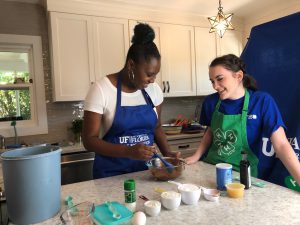 Healthy Living is one of the 4-H’s. While your club may not specifically focus on what is traditionally considered to be “healthy living” activities, you might be surprised about much your 4-H club is contributing to the mental and physical well-being of youth members. After we recognize that all our clubs have a role to play in implementing healthy living strategies across the county 4-H program, we can start to consider ways to be intentional in how we incorporate healthy living into 4-H activities and projects.
Healthy Living is one of the 4-H’s. While your club may not specifically focus on what is traditionally considered to be “healthy living” activities, you might be surprised about much your 4-H club is contributing to the mental and physical well-being of youth members. After we recognize that all our clubs have a role to play in implementing healthy living strategies across the county 4-H program, we can start to consider ways to be intentional in how we incorporate healthy living into 4-H activities and projects.
What does a 4-H Healthy Living program include? A 4 H Healthy Living program or strategy is any activity or program component that can help youth lead lives that balance physical, mental, and emotional health.
According to the National 4-H Council, 4-H Healthy Living programs include objectives that can help “empower youth to be healthy – body and mind – with the skills to make healthy decisions and lead healthy lifestyles. Having the confidence and skills to lead healthy lifestyles not only improves overall well-being; it enables youth to tackle life’s challenges today and become leaders in their lives, careers, and communities as they grow into responsible adulthood” (National 4-H Council, 2021). Your club focus might fit into one of the following program areas: mind, body, leadership, or mentorship.
As a club leader, you may encourage your youth to adopt goals and projects that will cover multiple program areas. Introducing healthy living during club meetings is another way to incorporate these concepts and help youth develop healthier habits.
With so many possible topics to consider, it may seem overwhelming to choose a starting point. In this article, a few suggestions will be explored.
Sleep
It may be surprising to learn that youth, like adults, are not getting enough sleep. Regularly missing hours of sleep or experiencing poor sleep quality can contribute to a variety of issues for youth. The Sleep Foundation is one resource to use for tips on how to encourage our 4-H members to adopt better sleep habits (Pacheco, 2021).
Some ideas for helping your 4-H youth learn about the importance of sleep and how to develop better sleep habits include the activities and lessons listed in the links below this paragraph. Consider challenging your youth to set healthy sleep goals for one month. Discuss the potential benefits during your goal setting activity. At the end of the month, discuss how youth felt on days when the sleep goals were met and how they felt on days when they did not meet their goal.
Activity for Teens (Intermediates and Seniors)
University of Wisconsin Extension. 2007. “4-H Get Fit, That’s It. Lesson 2: Are You Getting Enough Sleep.” Link to activity: https://api.ag.purdue.edu/api/DepotWS/File.ashx?t=f&i=98730
Activity for Elementary School Age (Juniors 4-H Members)
The Nemours Foundation. 2015. Sleep. Kids’ Health in the Classroom.
https://classroom.kidshealth.org/classroom/3to5/body/functions/sleep.pdf
Hydration
One way to incorporate a healthy living strategy into your 4-H program is offering water at all your meetings and limiting the inclusion of other beverages. A 4-H lesson on hydration can include STEM principles as youth can calculate their daily water needs based on their body weight. A fun way to encourage water consumption is to personalize reusable water bottles as a club activity and to award points to youth who remember to bring their bottles to meetings and activities.
All Ages Lesson and Activity
National 4-H Council.2020. How Much Water Do You Need? 4-H Healthy Living Activity Guide.
https://4-h.org/wp-content/uploads/2019/04/4H-Healthy-Living-Activity-Guide.pdf
Other Ways to Incorporate Healthy Living into Your Club Programs
Activities designed to improve sleep and hydration are only two of many possible ways to incorporate healthy living into your 4-H program. Healthy Living activities can incorporate exercise, nutrition, and ways to improve and maintain mental health.
Resources
Caruso, L.; Shelnut, K.; Kauwell, G. 2017. Hydration Myths. UF/IFAS Extension. Retrieved January 16, 2022 from https://edis.ifas.ufl.edu/publication/FY1409.
National 4-H Council. 2021. Healthy Living. Retrieved January 16, 2022 from https://4-h.org/parents/healthy-living/.
Pacheco, D. 2021. Children and Sleep. The National Sleep Foundation. Retrieved January 16, 2022 from https://www.sleepfoundation.org/children-and-sleep.
University of California 4-H Youth Development Program. 2022. Sleep for Better Living. Retrieved January 16, 2022 from https://4h.ucanr.edu/Projects/HealthyLiving/Sleep_for_Better_Living/
by Rachel Pienta | May 20, 2021
 What is Delegation?
What is Delegation?
Delegation can be one of the most difficult leadership skills to master. Otherwise capable leaders often say that the idea of delegation is a bit scary. What if I delegate a task and it does not get done? What if I give someone a job to do and it does not get done exactly the way I envisioned? In the following paragraphs, you will read about strategies that you can adopt to become a leader who can delegate effectively with confidence.
What is delegation? Let’s start with the meaning of the word. The word “delegate” can be used as a noun or a verb. In the world of 4-H, we use the word frequently in both forms. We may send a delegate or contingent of delegates to conferences or meetings to represent our organization. The focus of this article will be on the verb form of delegate. According to the Merriam-Webster dictionary, the act of delegating means “to entrust to another, to assign responsibility or authority.” In 4-H, leaders are encouraged to delegate to team members, including both volunteers and youth.
As a 4-H leader, learning how to delegate will be instrumental for your clubs and club members in several ways. In your role as a club leader, you will want to delegate responsibilities and tasks to other volunteers as well as youth. Additionally, teaching 4-H youth how to delegate imparts a valuable leadership skill.
Mastering the Art of Delegation
Mastering the art of delegation is a key time management skill for 4-H club leaders. Learning to delegate tasks to other adult volunteers as well as club youth will contribute to the success of your club and support your longevity as a volunteer leader. The one sure way to become overwhelmed as a 4-H volunteer is to make the error of trying to do everything yourself.
Skillful delegation is one of the hallmarks of a transformational leader. In 4-H, the essential elements that serve as the foundation of our positive youth development programs are categorized into four key concepts: belonging, independence, mastery, and generosity.
When a leader entrusts a task to another volunteer or youth, the person feels trusted and valued. Delegation is one way to help establish a sense of belonging. Volunteers and youth alike will feel like an important part of the group because they have been given a role through delegation. Youth who are entrusted to complete a task have the chance to experience independence. Leaders who delegate also give youth an opportunity to demonstrate mastery of important life skills. Practicing delegation in the club leadership role is a way to empower other volunteers as well as youth to experience and practice generosity through contributing time and talent to the organization and the larger community.
A SMART Way to Delegate
Delegation is a key element in setting and achieving a group’s SMART goals. The SMART goals acronym describes a process for goal setting that can be used with volunteers and youth.
S – Specific
M – Measureable
A – Attainable (or actionable)
R – Relevant (or realistic)
T – Time-bound
While SMART goals can be used for individuals to plan out projects, SMART goals are also a helpful tool to use with groups as a SMART way to delegate! A 4-H leader can use the elements of the SMART goal process as a guide to assigning tasks to other volunteers or 4-H youth. Leaders who learn to delegate goal-oriented tasks that follow the SMART formula will find that objectives are successfully achieved.
Another way to think about delegation as a process is the P.A.T. system. P.A.T. is an acronym that stands for Purpose, Action, and Timeframe. To delegate effectively, a leader should communicate the purpose or “why” a person is being entrusted with a task or objective. The amount of detail you provide about the actions needed to complete the task depends on the level of autonomy you want to give the person who receives a delegated task. As a club leader who wants to foster independence in your club members, how you determine the autonomy level to give youth is a critical step in developing young leaders. As you become more confident in your delegation skills, you may provide fewer action details and give other volunteers or youth the opportunity to make independent decisions about how to accomplish a delegated task. Finally, establishing a timeframe for completing the assigned task gives a defined time-bound end point to the delegation process, similar to the “T” in SMART goal setting.
For youth leadership development, delegation can be a learning experience in two ways. One way to help youth learn leadership skills is to entrust them with tasks to complete. The second way to help youth learn delegation is to assign authority to lead a team working on a project that will require delegation task for successful completion. Teaching delegation skills is one way club leaders can enable youth to act as leaders.
Strategies to Teach Delegation Skills
In the EDIS document Exemplary Youth Leadership Series: Enable Others to Act, two exercises are presented that provide opportunities for youth to learn and practice delegation skills. The activities outlined below appear in the linked EDIS document. These activities may also be adapted for use with adult volunteers.
Activities
Trust Builders—Participants will create an environment of trust.
Materials: Scissors, tape, pipe cleaners, paper, markers, straws, etc.
Group size: Divide the group into groups of 4–5 people.
Before starting this activity:
- Make sure you do not mention anything about trust to the participants.
- Gather a list of random supplies, but make sure you have a limited quantity of everything for the size of the group.
- Create a list of tasks based on the supplies that are present. For example, cut out a green heart. Make a flag out of yellow paper and a straw. Write everyone’s initials on the flag in black marker. The number of tasks can align with the time limitations of the overall activity (i.e., more tasks, more time).
- Divide the supplies into the number of groups present. Ensure that each group does NOT have all of the materials necessary to complete the task. Only have one set of critical items (tape, scissors, etc.).
Instructions:
- Tell the participants they are in a race.
- In a moment, they will be given a list of tasks to complete. The first team to get all of their tasks done correctly wins.
- Hand out a list of tasks and each group’s supplies.*
*These instructions are purposely vague so participants realize that they need to share resources to accomplish all tasks. This may not be immediately evident; however, participants will identify this is the only means to complete the activity. Do not give them parameters on how to share or barter to ensure the task is completed.
Wrap-Up Questions:
- How are we feeling after completing that experience?
- Winning group—what was your strategy?
- Could you have completed any of this on your own?
- Did everyone share equally and honestly with each other? Why?
- In what scenarios do we need to lean on the support of others to accomplish our tasks?
Photo Scavenger Hunt—Participants will demonstrate delegation.
Materials: Smartphones or cameras
Group size: Divide the group into equal-sized teams.
Instructions:
- Create a list of photos to take that are relatively easy to locate or find (e.g., a trash can, someone with red hair, a photo of a flower, participants spelling 4-H with their arms/torso, etc.).
- Tell the participants they are competing against the other groups to complete the scavenger hunt.
- Go over safety precautions or rules depending on location.
- Give youth the list.
- The first team with all of the correct photos wins.
Modification: If smartphones or cameras are not accessible, the photos could be replaced with items.
Wrap-Up Questions:
- The winning team—what was your strategy? Did you have one person take all of the photos or did you give each person a different task?
- What would have happened if we gave each person a different item they were in charge of? Do you think we would have been more efficient?
- Why is it important for us as leaders to be able to give other people tasks?
- How can we delegate responsibilities when we are faced with challenges?
Next Steps
There are many opportunities for youth and volunteers to develop leadership skills such as the art of delegation over the course of their 4-H experience. Incorporate one of the activities described in this article into a 4-H club meeting or volunteer training! For more information, training opportunities, resources, and opportunities to become involved with 4-H, please contact your local UF/IFAS Extension office.
Resources
Delegation
Delegation defined…and applied
Great Leaders Perfect the Art of Delegation
How to Delegate Effectively: 7 Tips for Managers
How to Start Delegating Tasks Effectively (Step-by-Guide)
Seven Strategies for Delegating Better and Getting More Done









